#paradoxides
Explore tagged Tumblr posts
Text

Morocco Fossil Trilobite Paradoxides gracilis 15.9” Cambrian Age
#paradoxides#Morocco#Cambrian#trilobite fossil#trilobite#trilobites#fossil#fossils#fossilized#prehistoric#png#transparent#ebay#paleontology#paleoblr
248 notes
·
View notes
Text


















Cambrian Critters!
Anomalocaris - Opabinia - Wiwaxia
Canadaspis - Haikoucaris - Hurdia
Myllokunmingia - Conodont - Haikouichthys
Pikaia gracilens - Hallucigenia - Eldonia
Elrathia kingii - Marella - Paradoxides
Pomatrum - Helicoplacus - Vetuicola
Stickers || Phone Wallpapers Masterlist
Planned or in the works: Cambropachycope, Amplectobelua, Stanleycaris, Balhuticaris, Kylinxia, Chancellorid, Omnidens
#art#my art#paleoart#paleontology#science#illustration#cambrian#anomalocaris#opabinia#wiwaxia#canadaspis#haikoucaris#hurdia#myllokunmingia#conodont#haikouichthys#pikaia#hallucigenia#elrathia#paradoxides#marella#pomatrum#helicoplacus#vetuicola
334 notes
·
View notes
Text
daily vivosaur 61
Genus: paradoxides
A large trilobite from the cambrian period, It grows to support the team with an LP healing skill and high speed, it enters the battlefield with payback applied to counter attacks right away

#my art#paleoart#paleo art#trilobite#paradoxides#fossil fighters#3d art#low poly#low poly art#blockbench
29 notes
·
View notes
Text
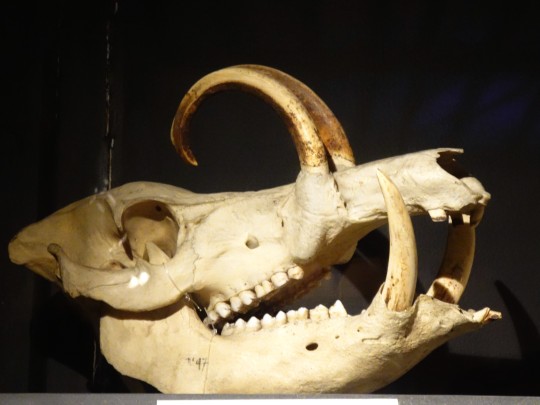
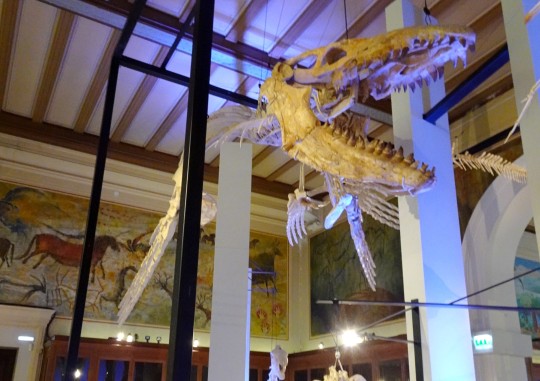
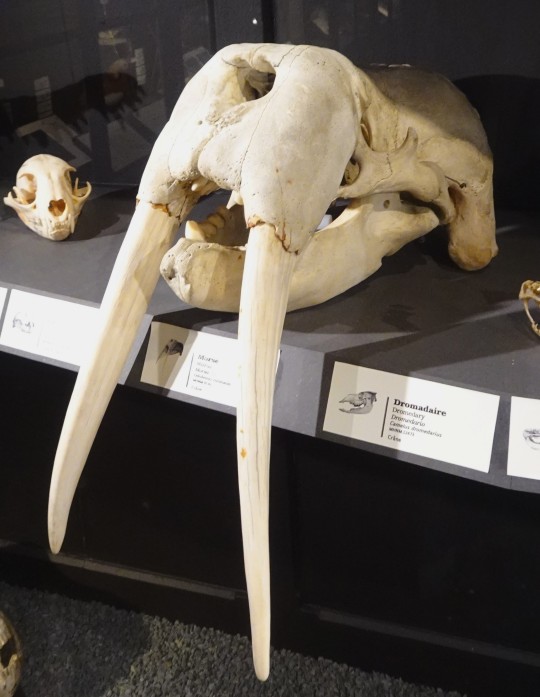
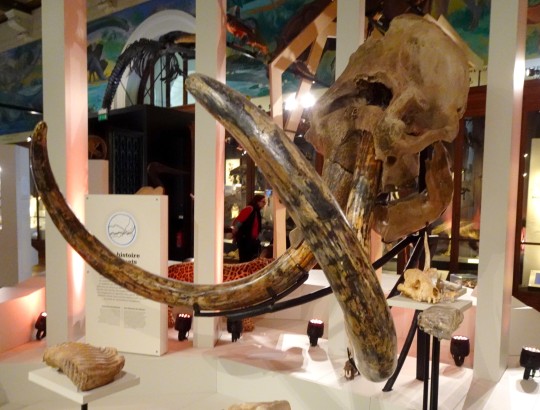
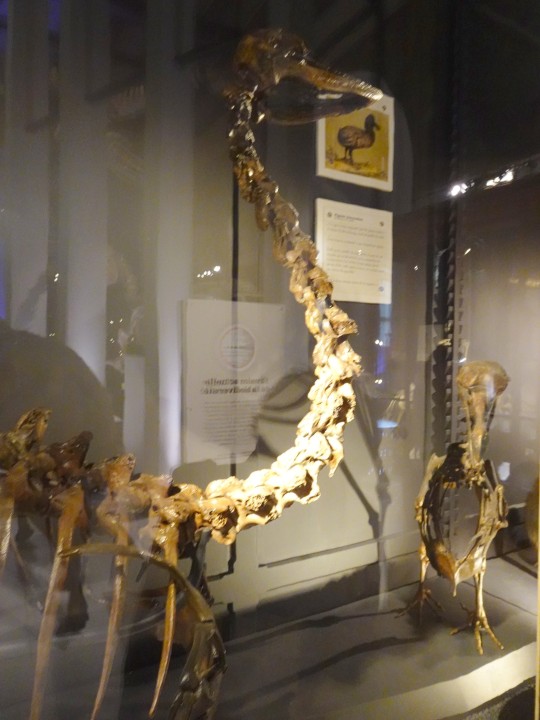
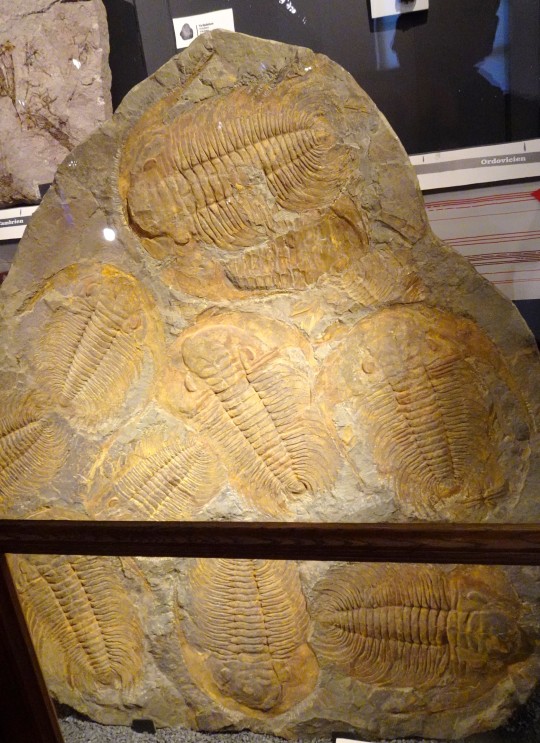
Marseille. Je reviens à il y a une vingtaine de jours (avant l'arrivée du Belem). Christine est là.
Et nous sommes au Palais Longchamp, qui abrite deux musées dont celui-ci, le Muséum d'Histoire Naturelle :
crâne de Babiroussa
squelette de Mosasaure Prognathodon
crâne de Morse
crâne de Mammouth laineux
squelettes de deux oiseaux (assez) récemment disparus : l'Aepyornis (Oiseau-Eléphant) de Madagascar et le Dodo
fossiles de Trilobites Paradoxides gracilis.
#marseille#palais longchamp#muséum#muséum d'histoire naturelle#fossile#paléontologie#squelette#babiroussa#suidés#mosasaure#prognathodon#mammouth#crâne#aepyornis#dodo#dronte#trilobite#paradoxides#paléozoïque#mésosoïque#madagascar#oiseau-éléphant
7 notes
·
View notes
Text

Welcome back to Trilobite Tuesday! Pictured is a large Paradoxides trilobite that measures over 12 in (30.5 cm) long. This species can be found amid the treacherous sea-side cliffs of Middle Cambrian formations in Wales. However, a nearly identical Paradoxides species can be found 2,485 mi (4,000 km) away in Newfoundland! This serves as an example of plate tectonics, which explains how continents move ever-so-slowly over the course of hundreds-of-millions of years.
601 notes
·
View notes
Text



Trilobites: Paradoxides and Isotelus
14 notes
·
View notes
Note
Imagine you can choose one (1) extinct animal to become well-known by the public, like the equivalent of "t-rex" (where everyone at least knows what it is, and has a vague sense of what it looks like, even if they don't care about dinosaurs). Which do you pick? (If you can't pick just one, narrow it down to a handful, and the Hypothetical Situations Genie will pick whichever they think is the coolest, but the genie will get frustrated if they have to choose from between more than three, and will make it so that people regularly get the creature's name wrong, in whatever way would most annoy you.)
Hmmm
To be honest I'm convinced every dinosaur is well known, even stuff that I assume is obscure ends up having toys and stuff made of it and appears in the latest Jurassic World Epic Cartoon or whatever it is they're doing with the IP
And I can think of loads of little-known prehistoric critters but again not sure what amount of little-known would count? Like I think Mamenchisaurus is well-known but I'm sure my dad wouldn't know what the heck that is (and goodness knows the world needs more Mamenchisaurus)? And naming Paradoxides would be hard but it's still a very recognizable giant trilobite?
But maybe, off the top of my head, Estemmenosuchus

Vulcanodon (ugh those dorsal spines)

and Synthetoceras?
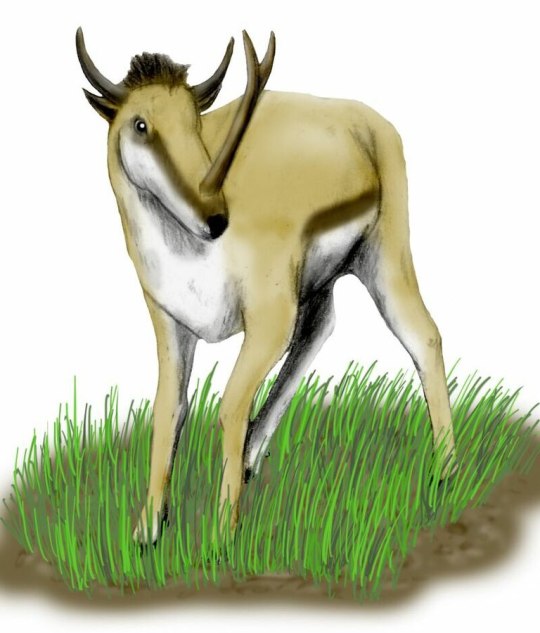
36 notes
·
View notes
Text
Trilobites are Cute
Some time back I had this hobby of collecting rocks precious stones mostly; like this wonderful purple cluster of amethyst, and this cluster of quartz that has collected dust over the years. Now these stones come in many pretty shapes and sizes, but my favorite has to go to this; a fossil of a trilobite. This ancient arthropod, now cast in stone, is part of a very diverse and successful group, that dominated this Earth for millions of years; all the way from the Cambrian explosion to the Permian mass extinction, just before the Triassic period.
10 to 8 years ago, I obsessed over these guys and they were quite interesting. Now there have been no trilobites since before even the dinosaurs came, so what we have left is the fossil record which preserves just their exoskeleton. And while we know their morphology well from this, we know very little about their behaviors their viscera and even their coloration. Those details cannot be reflected in the fossil record, and so are lost to history. Nonetheless there are some nice things that have been preserved in the fossil record; like how this one has spines, and how this one has more spines, and how this one has even more spines. These spines were of course for defense as trilobites did have predators...and also they prayed on stuff as well. Some trilobite spines look really really weird.
This one has a trident coming out of its glabellum, and apparently it's a sensory organ of some sort ... quite elegant. And while most trilobites are blind, some of them actually had eyes and not just eyes - compound eyes. It's amazing how not so long after the Cambrian explosion, where multicellular animal life just began, that some of these guys were able to evolve such complex apparatuses for seeing the world outside. Some of these guys even had their eyes on stalks, which is quite interesting. Look at how cute this one is.. like a snail. Trilobites can be real small or like Paradoxides here really large. Paradoxides is 30 cm long, so it's really huge they actually look kind of like horseshoe crabs, which is not surprising because horseshoe crabs are really really ancient. These guys lived on this Earth since the early Ordovician and are really really weird; they are not even Crustaceans, they chelicerates - most similar to arachnids. These guys are living fossils and they come to the beach to mate like this, so trilobites are possibly the same.
They have a special blue blood that clots literally instantly and in the medical field there's something called LAL which is extracted from this blood which is very useful. We literally make a hole in their heart to extract this industrially, and they're fine after this! Being somewhat related to this, trilobites may have had similar properties. The fossil record is no way complete and reflective of the true diversity, but what we have is pretty good and we can use it really nicely to speculate of what about what they could have been.
Horseshoe crabs saw the dinosaurs come and go, but these guys didn't make it past the Permian. What we have left are the fossils, and from these fossils we can say - trilobites were cute.
Achinthya Nanayakkara
22.03.2025
2 notes
·
View notes
Photo

*gives you a paradoxides trilobite*
#plush#plushie#plushies#plushblr#plushcore#toycore#soft toy#stuffies#trilobite#cambrian#paleozoic#crustacean#paradoxides#prehistoric#plush: crustacean#plush: prehistoric
1K notes
·
View notes
Photo

Fossil of the trilobite Paradoxides.
71 notes
·
View notes
Video
Paradoxides acadoparadoxides trilobite from Sidi Abdallah Ben el Hadji, Morocco. A beautiful example of the Paradoxides genus dating back to the Palaeozoic era, lower Cambrian approximately 550 million years. See more: https://www.thefossilstore.com/fossils/marine-creatures/trilobites
#Trilobite#Fossil#TrilobiteTuesday#Geology#Collection#Bronze#Instagram#mount#the earth story#cambrian#morocco#Paradoxides
37 notes
·
View notes
Text

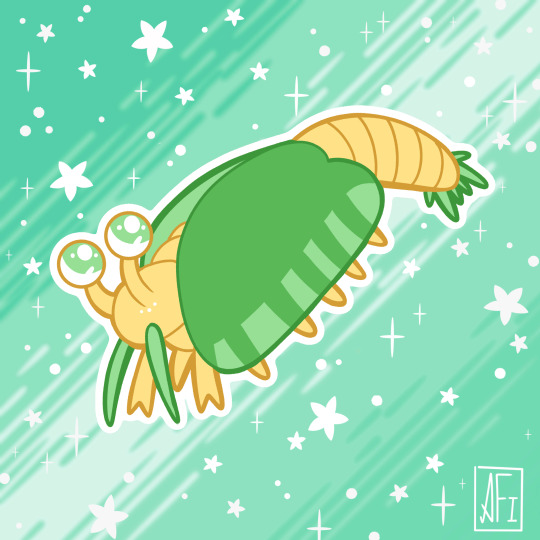

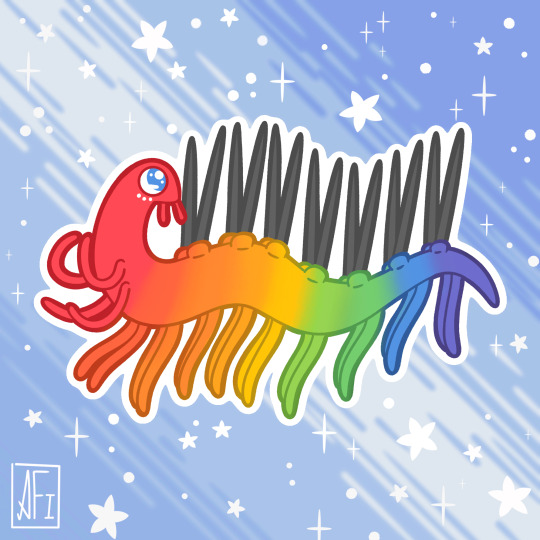


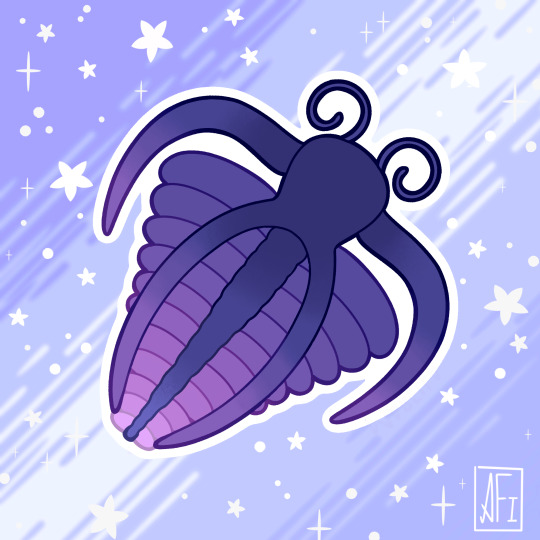
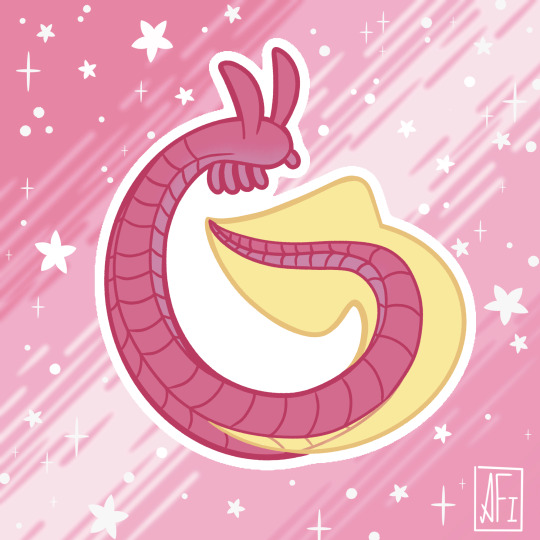
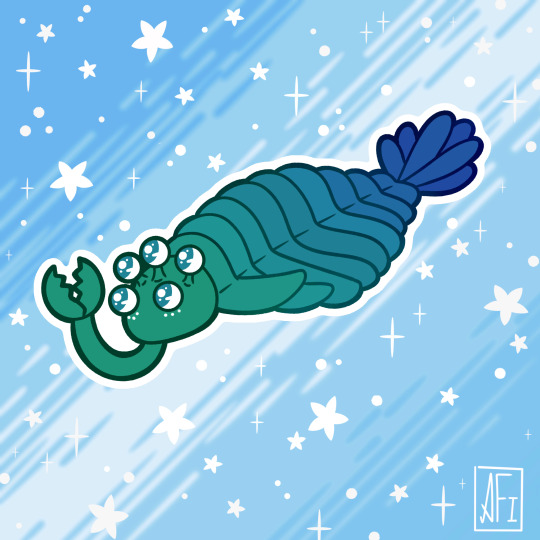

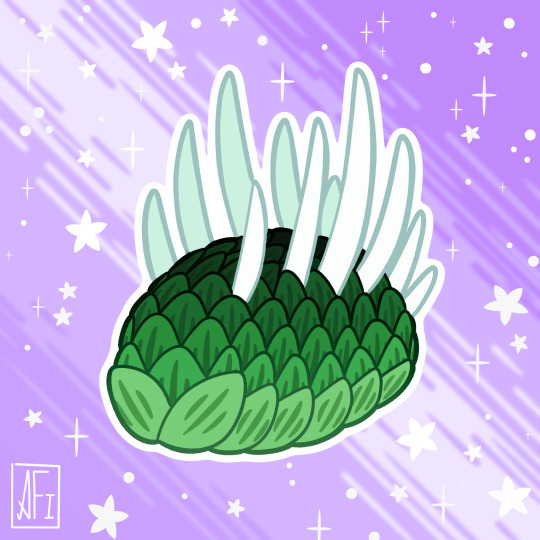

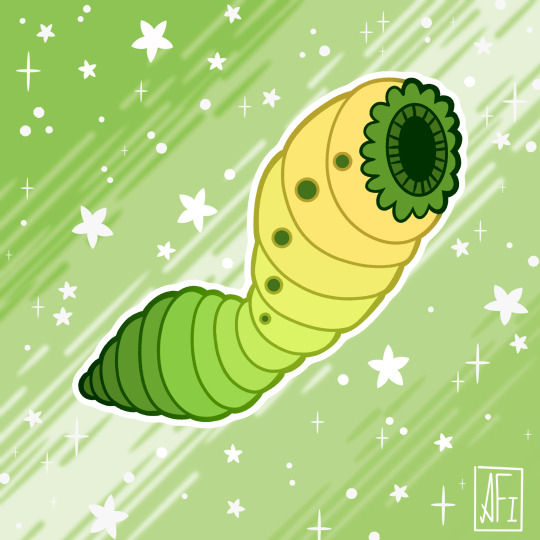
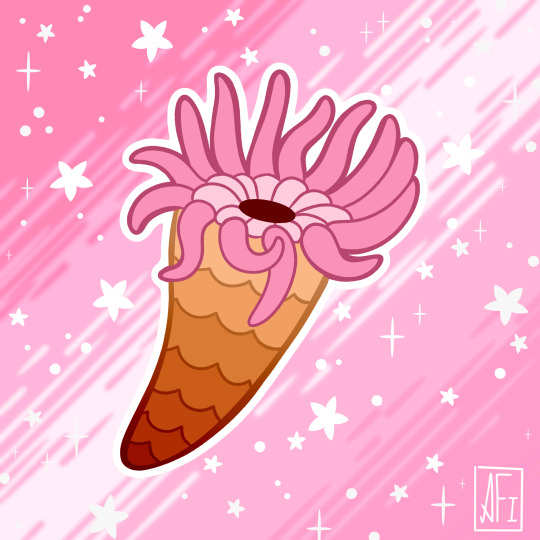

My entire Cambrian Catalogue!
Anomalocaris - Canadaspis - Eldonia
Hallucigenia - Helicoplacus - Hurdia
Marella - Pikaia - Opabinia
Haikoucaris - Wiwaxia - Paradoxides
Pomatrum - Rugose Coral - Vetuicola
Are there any missing here that you'd like to see?
#my art#paleontology#paleoart#science#cambrian#anomalocaris#canadaspis#eldonia#hallucigenia#helicoplacus#hurdia#marella#pikaia#opabinia#haikoucaris#wiwaxia#paradoxides#pomatrum#rugose coral#vetuicola
343 notes
·
View notes
Text
Animals and Exhibits
Animal Directory
Below is a list of all of our De-Extinct Species, and a link to their profiles; the list is in alphabetical order. Species Profiles are underway, and the site will be updated with them soon!
Angistorhinus
Anomalocaris
Archeopteryx
Archelon
Arthropleura
Attenborosaurus
Basilosaurus
Beipiaosaurus
Buenellus
Camptosaurus
Cephalaspis
Compsognathus
Dearc
Drepanosaurus
Dryosaurus
Dunkleosteus
Eidacaria
Erettopterus
Gigantopithecus
Glyptodon
Hallucigenia
Hatzegopteryx
Inostrancevia
Leptocleidus
Liopleurodon
Longisquama
Mawsonia
Meganeura
Mosasaurus
Moros
Nanuqsaurus
Paradoxides
Parasuchus
Psittacosaurus
Sharovipteryx
Sinosauropteryx
Spinosaurus
Therizinosaurus
Thylacinus
Titanoboa
Tyrannosaurus
Velociraptor
Xiphactinus
Yutyrannus
Zhenyuanlong
We also have a multitude of other non-extinct animal species here at New Horizons, many of which can be seen throughout the sanctuary. Signs along our path will inform visitors of the many native species that call New Horizons home.
Exhibit Directory
Cenozoic World:
A comparatively small period of time in the history of the world, the Cenozoic is no less amazing than its earlier counterparts. Our Cenozoic World has several species of amazing animals, such as the mighty Titanoboa and the Gigantopithecus.
Cretaceous Aquarium:
This aquarium shows off our wonderful species that hail from the Western Interior Sea of Cretaceous North America such as Mosasaurus, as well as a small aviary for the Hatzegopteryx flock!
Egyptian Seas:
Home to three exhibits, our Egyptian Seas is one of our largest singular species exhibits. Our Spinosaurus breeding pair lives here, as well as whatever young they have. The small aquarium exhibits also have Mawsonia and Leptocleidus, two species that would have lived alongside Spinosaurus.
Gobi Desert:
This small area has two different exhibits to it, one for the famous Velociraptor, where we have our lesbian pair of Velociraptors; as well as our Therizinosaurus exhibit. Both of these exhibits are modeled after the ancient Gobi Desert, where they would have lived.
Laurasian Savannah:
Our Laurasian Savannah has two exhibits included, our smaller Underbrush, and our larger Scrublands, featuring the largest herd of Camptosaurus’ of any paleozoological location!
Pangaen Plains:
Our Pangean Plains is right after our Primordial Aquarium, and displays our Inostrancevia enclosure and our Triassic House, showing off the drepanosaurs and phytosaurs of this time period!
Primordial Aquarium:
The Aquarium directly after the entrance location houses several exhibits, featuring a variety of pre-Permian life from our oceans! Some species include the bony fish Dunkleosteus and the bizarre Hallucigenia. Also in the Aquarium is a touch tank for our Cambrian life.
Tethys Aquarium:
For much of our planet’s history, the continents were split by the Tethys Sea. This aquarium and aviary shows some of the species that called these coasts and waters home; such as the mighty Liopleurodon and the soaring Dearc.
Tyrannosaur Hollow:
New Horizons has three species related to the Tyrant Lizard King. Moros and Nanuqsaurus join Yutyrannus in our Tyrannosaur Hollow, just past the Yixian Rainforest. Then we have the King of the Dinosaurs himself, our Tyrannosaurus, Hank, and his several young children, who are still growing!
Yixian Rainforest:
Paired right next to Tyrannosaur Hollow, the Yixian Rainforest exhibits many species well known to paleontology, including our world famous Psittacosaurus’ and the feathered menace Yutyrannus.
Veterinary Facility
While usually off limits to the public, the veterinary facilities of New Horizons rival the best of the best. Our technology is cutting edge, and strives to continue our place at the forefront of paleo-veterinary practices and study.
The main room of our veterinary facility could fit a Giganotosaurus, but our animals larger than two tons typically are given ‘exhibit calls’. A multitude of other rooms are available for our aquatic animals, as well as our smaller ones. Laboratories for medical discoveries, radiology rooms, and recuperation wards are all in our building as well, each tailored for their purpose.
#new horizons paleozoological sanctuary#paleozoo#prehistoric planet#artists on tumblr#digital art#dinosaurs#geology#natural history#zoo#wildlife#dinosaur#realistic dinosaur zoo#prehistoric park#prehistoric creatures#prehistoric humans#prehistoric life#fossils#prehistoric animals#paleontology#paleoart#prehistoric art#prehistoric reptile
11 notes
·
View notes
Text
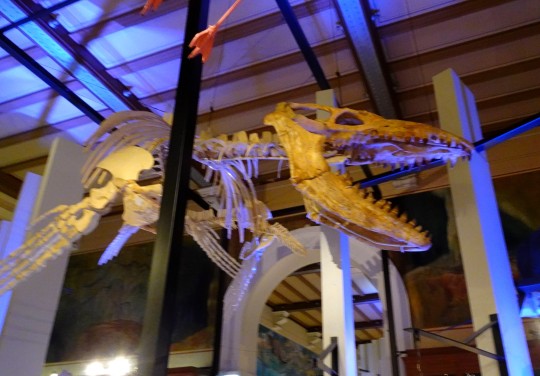
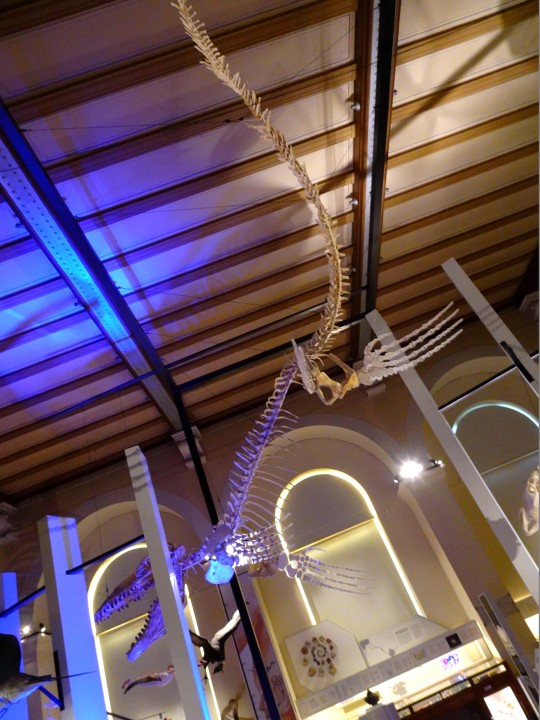
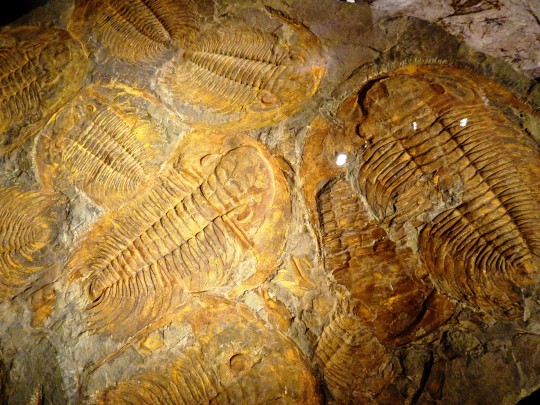
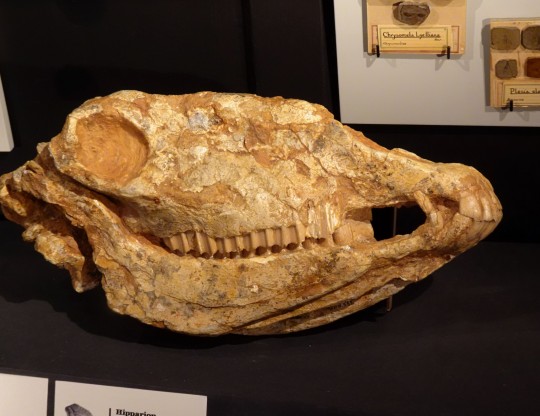
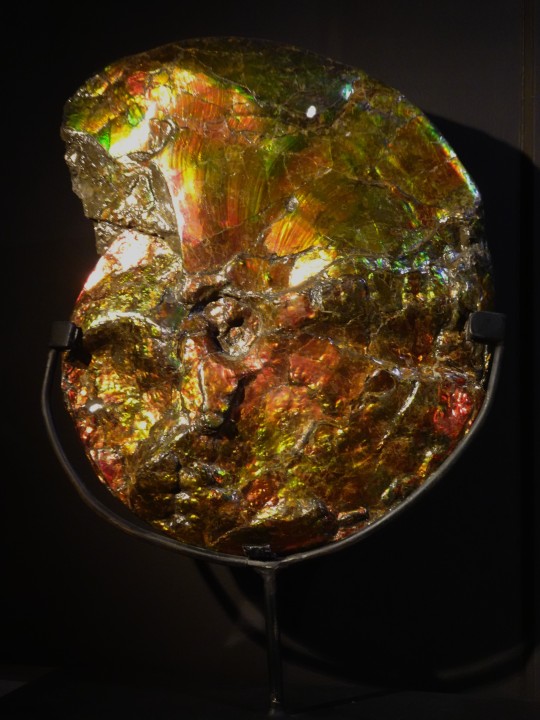
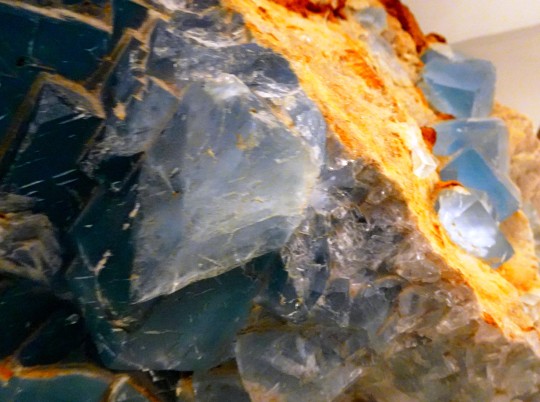
Marseille. Le Palais Longchamp abrite deux musées, ici le Muséum d'Histoire Naturelle.
Mosasaure Prognathodon
idem
Trilobites Paradoxides gracilis
crâne d'Hipparion, miocène
ammonites fossilisées en opales, je suppose ??(pas d'explication sur place)
cristaux d'améthyste, je pense (là, c'est ma faute : je ne l'ai pas noté !)
#marseille#longchamp#palais longchamp#muséum d'histoire naturelle#paléontologie#fossile#mosasaure#prognathodon#mésozoïque#trilobite#paradoxides#paléozoïque#hipparion#cheval fossile#équidés#miocène#néozoïque#cristal#cristaux#améthyste#opale#ammonite#crâne#crâne de cheval
4 notes
·
View notes
Text






Trilobites are extinct animals that have a shell made of “rock”—and sometimes, these animals record examples of failed predation within their suit of armor. New research by Russell Bicknell, a postdoctoral researcher in the Museum’s Division of Paleontology, examined unique specimens that showcased extreme examples of such injuries. These rare fossils show how trilobites were often at the bottom of the food chain and were food for bigger animals. These specimens also provide important insight into how trilobites recovered from failed predation.
Image 1: Paradoxides bohemicus Image 2: Close up of Paradoxides bohemicus injury Image 3: Ogygopsis klotzi Image 4: Close up of Ogygopsis klotzi injury Image 5: Olenoides serratus Image 6: Close up of Olenoides serratus injury
Photos courtesy of Russell Bicknell
#science#amnh#museum#fossil#natural history#paleontology#nature#animals#trilobite#arthropods#research#stem
507 notes
·
View notes
Text
Meet the Fossil Detectives in the Basement
by Suzanne Mills and Albert Kollar
Gray metal storage cabinets march in rows across the concrete floor. The collection space has no windows and there is a constant hissing sound from the overhead air ducts. No matter, the staff is looking for clues of the geologic and paleontological past, or History of the Earth, through the vast collection of fossil invertebrates. The staff and volunteers of the Section of Invertebrate Paleontology (IP) is tasked to reorganize, preserve, and curate fossils through the leadership of the Collection Manager Albert Kollar.
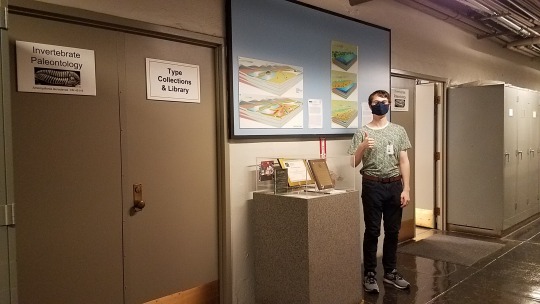
Collection Assistant Kevin Love at the doors of the Invertebrate Paleontology section.
On any given workday, you’ll find us hefting drawers full of fossil-bearing rocks and playing specimen-box Tetris to make fossils fit in the available cabinet space. We examine century-old inventory books, search out (usually Google) maps to find absconded valuables (historical fossil sites), and decipher written scripts in unfamiliar French and German for valuable geologic data.
Long-term volunteers in IP include Rich Fedosick, a researcher assisting in the project to document the Carnegie building stones; John Harper, an expert on fossil snails taxonomy, Roman Kyshakevych, who is deciphering the famous Coppi collection from Italy; Tamra Schiappa, a paleontologist at Slippery Rock University who is updating fossil cephalopod identifications; and Vicky Sowinski, who performs collection support. Student researchers include collection assistant and graphic artist Kay Hughes, a 2021 Mount Holyoke College graduate who coauthored four peer-reviewed scientific publications produced by IP; and collection assistant Will Vincentt, who researched two Bayet collections, the Hunsruck Slate of Germany and Lyme Regis of England. Tara Pallas-Sheetz, a part-time assistant, has worked on various projects over the years.
Hear from some of our newest staff and summer volunteers in their own words below.
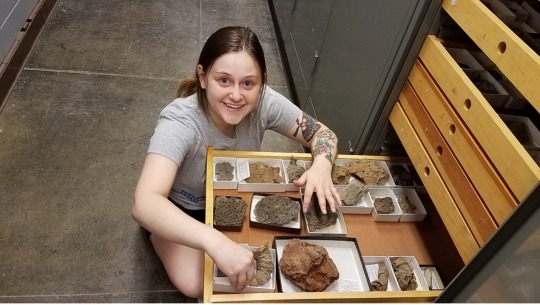
Lizzie Begley with large fossil corals
Name: Lizzie Begley
About me: B.A. Anthropology Penn State 2021; masters candidate in Museum Studies and Non-profit Management certification in progress at Johns Hopkins University
Why IP: Working “behind the scenes” in IP has helped me develop a better sense of what it looks like to work in a museum such as the Carnegie. As an aspiring museum professional, experience behind gallery floors is invaluable as I work to find my place in the field. For this experience I couldn’t be more grateful and, honestly, couldn’t be having more fun!
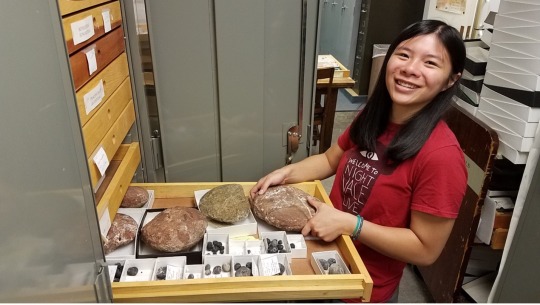
Katie Golden with fossil ammonites
Name: Katie Golden
About me: B.S. Biology, Juniata College 2023 (expected)
Why IP: When I was in preschool, I told people I wanted to be a paleontologist when I grew up. Here in IP, I like exploring a part of the museum that most people don’t get to see. I particularly enjoy puzzle-piecing together fossils that need repair. The intricate ammonites, trilobites, and insects preserved in amber are especially beautiful. My favorite fossil organism is Anomalocaris.

Tori Gouza with fossil corals
Name: Tori Gouza
About me: B.A. History and Anthropology, University of Pittsburgh 2023 (expected)
Why IP: I love working in IP. It is so exciting to be able to interact with others in the section and to learn what projects they are currently working on. Albert Kollar has encouraged not only discussion but also collaboration. It is great to converse with others who are passionate about their work.
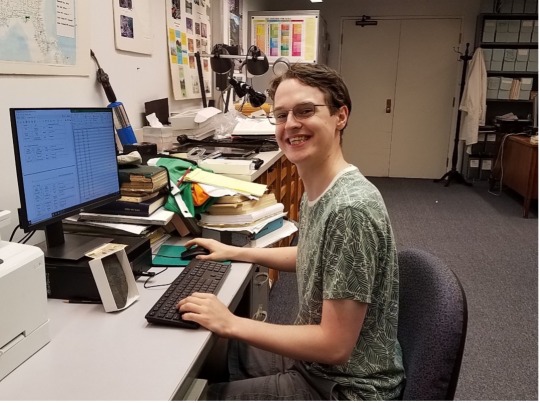
Kevin Love enters data about a fossil eurypterid
Name: Kevin Love
About me: IP Collection Assistant; B.S. Geology and Ecology & Evolution summa cum laude, University of Pittsburgh 2021
Why IP: I like solving puzzles at work. I find invertebrate fossils aesthetically appealing, but the main reason I like this job is that I get to understand little enigmas from Earth’s past. I like solving historical questions and compiling more information about fossils in the collection.
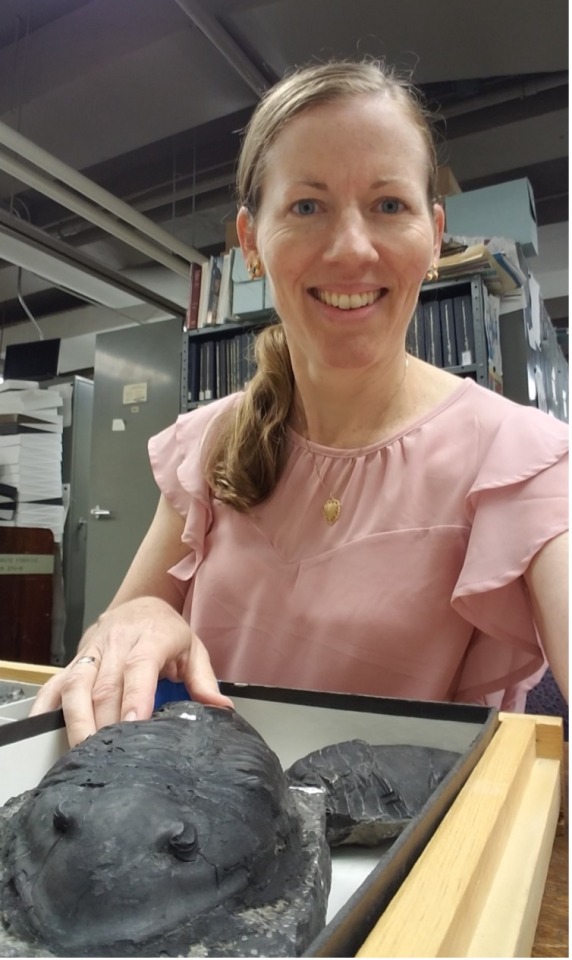
Suzanne Mills with fossil trilobite Isotelus gigas
Name: Suzanne Mills
About me: IP Collection Assistant, Professional Geologist, mom
Why IP: Every day is different when you work with a collection of 800,000 specimens. I may come across a 100-million-year-old ammonite sparkling with crystals inside, or a drawer full of trilobites acquired by the museum in 1903, when Andrew Carnegie was alive. I love that my work requires me to learn more about fossils which are beautiful, historical, and scientifically significant.
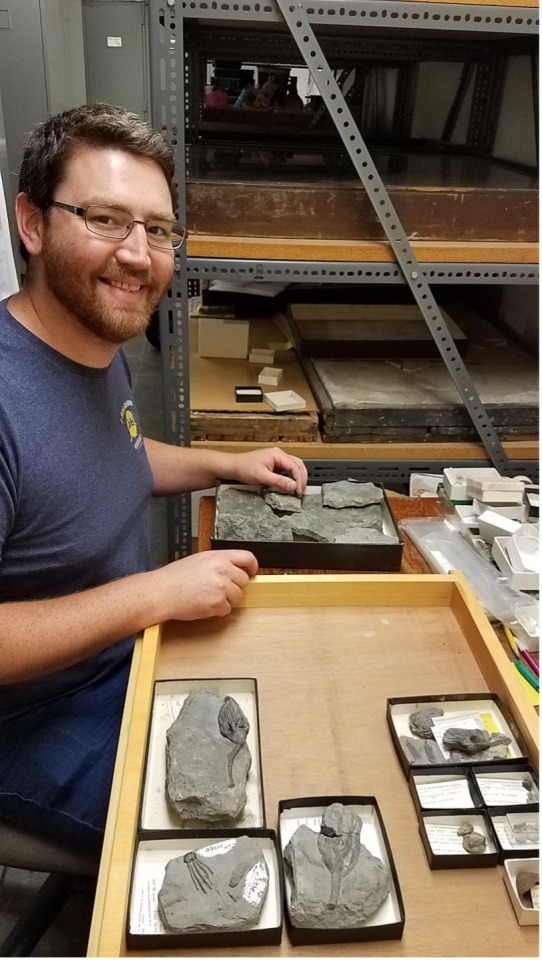
Ellis Peet with fossil crinoids
Name: Ellis Peet
About me: B.S. Environmental Geoscience with Geology concentration, Slippery Rock University 2021
Why IP: The management and staff of IP are smart, kind, personable, and they take paleontology seriously. I also like the environment at IP because it smells like a library and limestone dust, which reminds me of the geology department at Slippery Rock.
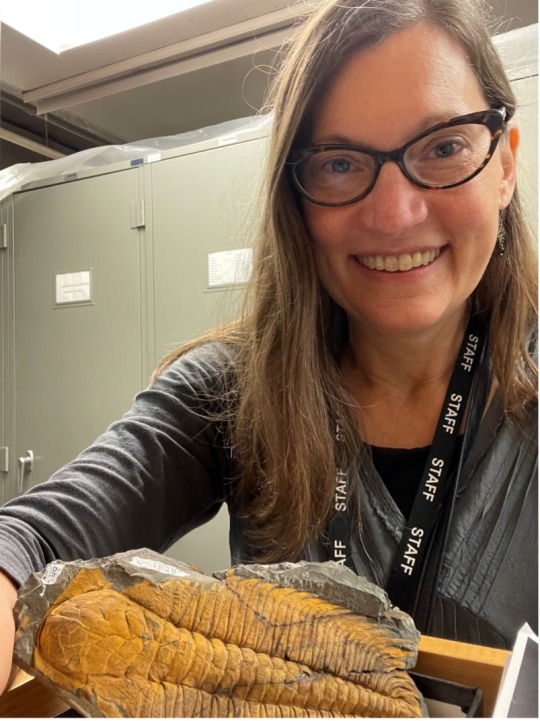
Joann Wilson with fossil trilobite Paradoxides spinosus from the Baron de Bayet collection
Name: Joann Wilson
About me: Interpreter for the Department of Education, Carnegie Museum of Natural History
Why IP: Fossils inspire awe. I enjoy unravelling the stories behind the individuals that discovered, studied and collected these breathtaking specimens.
Suzanne Mills is a Collection Assistant and Albert Kollar is Collections Manager in the Section of Invertebrate Paleontology at Carnegie Museum of Natural History. Museum employees are encouraged to blog about their unique experiences and knowledge gained from working at the museum.
#Carnegie Museum of Natural History#Natural History#Paleontology#Invertebrate paleontology#Fossils#Museum Work
70 notes
·
View notes